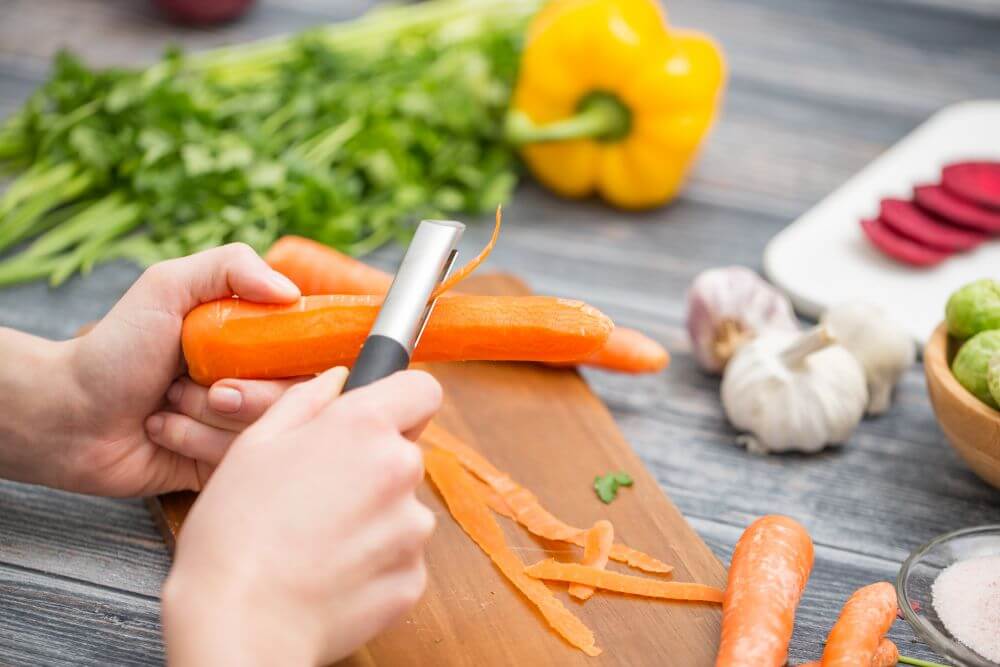To peel or not to peel: Do you really need to peel vegetables?

To peel or not to peel…?
Are you someone who peels every vegetable, regardless of how you are going to be cooking it? Or do you do it out of habit, reaching for the peeler on auto pilot?
Peeling vegetables (and many fruits) is a waste of food, time, money, fiber and nutrients.
In fact, peeling vegetables contributes a huge amount of unnecessary waste to our landfills and compost bins every year. You may not think those few potato skins make a difference, but collectively in New Zealand we throw away 13,658 tonnes of vegetables peelings and 986 tonnes of fruit peelings every year.
Most of this is waste that could be avoided because you don’t need to peel most of your produce. Instead just wash your fruit and vegetables before eating them to remove any dirt.
There are some instances where you may prefer to peel your vegetables, such as making mashed potato. However, don’t throw away the peels! Use them to make these delicious potato peel chips, vegetable stock or chuck them in the compost.
How to prepare vegetables without peeling:
Beetroot: Cut off the tops (but don’t throw away the leaves – use them to make one of these recipes). Wash well, you may need to use a brush if it is particularly dirty.
Carrot: Cut off the top of the carrot. Wash well.
Cucumber: Wash well.
Kumara: Wash well, you may need to use a brush if it is particularly dirty. Cut away any damaged parts of the kumara. If you do peel kumara, use the skins to make kumara peel chips.
Mushrooms: Use a damp paper towel or a brush to clean the outside of mushrooms.
Onion: Onions should be peeled before using. You can use onion skins when making stock or try this onion skin soup.
Parsnip: Cut off the top and wash parsnips before using. If you are going to consume a large amount of parsnips then you should peel them. Parsnips contain a group of natural toxins called furocoumarins which can cause stomach aches if consumed in large quantities. These toxins are concentrated on the surface of the parsnip so peeling them will help reduce the toxin levels.
Potatoes: Wash well, you may need to use a brush if they are particularly dirty. Remove all sprouts and green parts from potatoes before cooking. If you are going to make mashed potatoes, save the skins to make these crispy potato skins.
Pumpkin: Pumpkins skins are edible, so you don’t need to peel you pumpkin. If you do want to peel your pumpkin, the easiest way to do it is to roast or microwave the pumpkin, then peel the skin off. You’ll also end up wasting less pumpkin this way. If you do peel the pumpkin while it is raw, make sure to compost the skins.
Swede: If swedes are young and fresh then you don’t need to peel them. For older, tougher ones, remove the skin and put it in your compost bin.
Taro: Wash taro root well, but wear gloves when preparing to avoid the possibility of itchy skin. You do not need to peel taro as the skin is edible. Make sure you cook the taro thoroughly to prevent your mouth and throat becoming itchy due to a substance in raw taro called calcium oxalate. Click here to learn more about how to prepare taro leaves.
Yams: Wash well.
Zucchini: Wash well.
What you need to know about peeling fruit:
Apples: Wash before eating, you do not need to peel. If you do peel apples, save the peel to make jam or apple cider vinegar.
Bananas: Everyone knows that you need to peel bananas before you eat them, but did you know that you can use banana peels in baking? Try our banana peel cake.
Citrus: If eating raw, most people prefer to peel their citrus or eat around it. However, the rind is edible – and can be used for many things. You can freeze citrus rinds to use for zest in the future.
Kiwifruit: The skin of kiwifruit is edible.
Mango: You do need to peel mangos before you eat them as eating the skin can cause an allergic reaction in some people.
Melon: It may seem strange to eat melon rinds, but watermelon rinds are edible. You can fry them, add them to curries or pickle them. You should not eat rockmelon rind as it can carry harmful bacteria due to the texture of it.
Pears: Wash before eating, you do not need to peel.
Persimmons: Persimmon skins are edible, but remove the flowery top.
Next time you’re preparing dinner, think before you peel!



